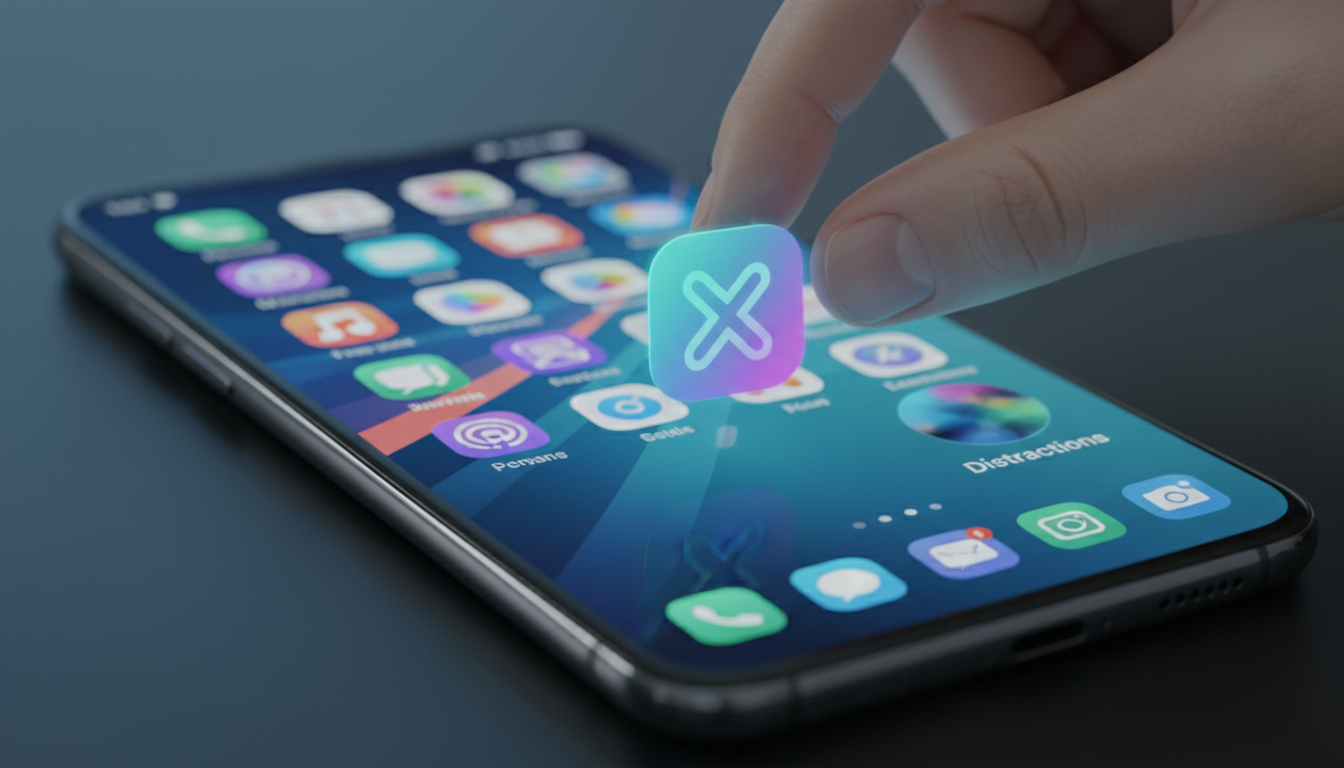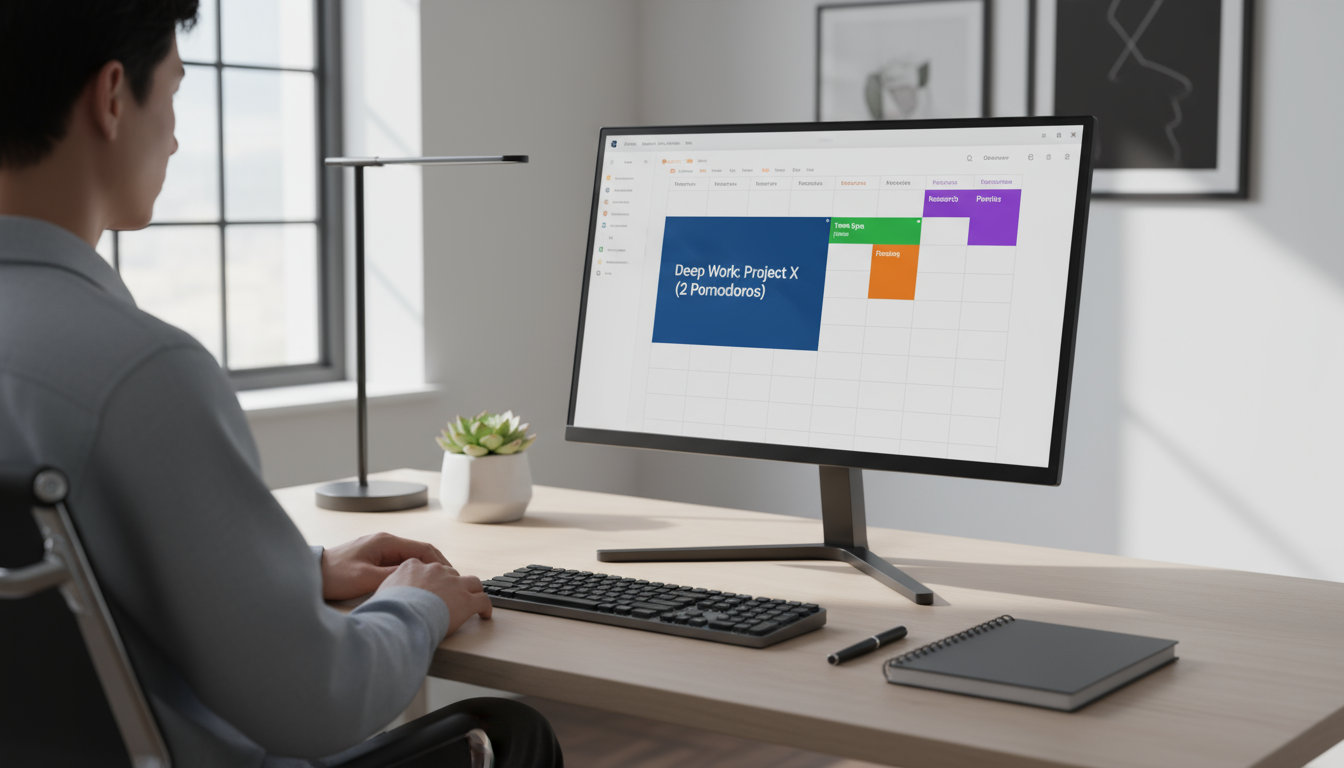
In the world of productivity, we often glorify heroic effort. We imagine the overnight success, the caffeine-fueled all-nighter, the sheer force of will that pushes a monumental project over the finish line. But this vision is a trap. It’s unsustainable, exhausting, and for most of us, it leads directly to burnout, not breakthrough.
The truth is far less dramatic and infinitely more powerful: sustainable productivity isn’t built on heroic sprints. It’s built on small, intelligent systems. It’s about creating a framework where focus is the default, not a daily battle. It’s about replacing willpower, a finite resource, with habit, an engine that runs on consistency.
You don’t need a complete life overhaul to reclaim your focus. You need a few low-friction techniques that work with your brain’s natural tendencies, not against them. This is where a simple kitchen timer, or its digital equivalent, becomes one of the most powerful tools in your arsenal. We’re talking about the Pomodoro Technique, but not just as a time management tool. We’re going to reframe it as the ultimate pomodoro timer hack for unlocking consistent sessions of deep work.
This guide will show you how to use pomodoro for focus in a way that feels easy and repeatable. We’ll move beyond the simple “25 minutes on, 5 minutes off” and build a complete system around it. Forget the herculean effort. It’s time to embrace the power of a simple, reliable timer and the focused work it protects.
📚 Table of Contents
- What is a Pomodoro, Really? The Foundation of Your Focus System
- Preparing the Battlefield: Micro-Hacks for a Distraction-Free Environment
- The One-Screen Phone Tweak
- The 10-Minute Desk Reset
- The 15-Minute Weekly Review
- The Time Audit Snippet
- Your Low-Friction Focus Stack: Tools You Already Have
- Compounding Your Focus: Chaining Habits for Exponential Gains
- Real-World Scenarios: Applying the Pomodoro Timer Hack
- Scenario 1: The Manager with a Fragmented, Meeting-Heavy Schedule
- Scenario 2: The Solo Maker with an Open, Unstructured Schedule
- Frequently Asked Questions About the Pomodoro Timer Hack
- Is one specific pomodoro timer tool better than others?
- What should I do if I get interrupted during a Pomodoro?
- What if I’m “in the zone” when the timer goes off? Should I stop?
- How does this method help with the mental cost of switching tasks?
- When should I quit a hack if it feels like it’s not working?
- A Final Word: Your First Three Steps to Sustainable Focus

What is a Pomodoro, Really? The Foundation of Your Focus System
Let’s start with the basics, because understanding the “why” makes the “how” so much more effective. The Pomodoro Technique was developed by Francesco Cirillo in the late 1980s. The premise is brilliantly simple: you break down your work into short, focused intervals, traditionally 25 minutes in length, separated by brief breaks.
A classic “Pomodoro” session looks like this:
1. Choose a task.
2. Set a pomodoro timer for 25 minutes.
3. Work on the task with singular focus until the timer rings. No email, no social media, no “quick” checks of your phone.
4. When the timer goes off, mark off one Pomodoro and take a 5-minute break.
5. After four Pomodoros, take a longer break of 15–30 minutes.
This sounds almost too simple to be effective, but its power lies in the psychological principles it leverages. It’s not about the timer itself; it’s about the clear, unambiguous boundary the timer creates. For 25 minutes, you have one job. This clarity defeats the paralysis that comes from staring at a massive project. Instead of “write the report,” your task becomes “work on the report for just 25 minutes.” Anyone can do that.
This technique is the perfect gateway to what author Cal Newport calls deep work. Deep work is the ability to focus without distraction on a cognitively demanding task. It’s a skill that allows you to quickly master complicated information and produce better results in less time. In our hyper-distracted economy, the ability to perform deep work is becoming increasingly rare and, therefore, increasingly valuable.
The pomodoro timer hack works because it trains your “focus muscle.” Every time you honor the timer—resisting the urge to check a notification or open a new tab—you are doing a repetition. The short breaks prevent mental fatigue, allowing you to sustain this high level of concentration for longer than you otherwise could. It turns an intimidating, multi-hour task into a series of manageable, 25-minute sprints. It manufactures a gentle sense of urgency that encourages you to start *now* instead of later.
Think of each Pomodoro as a building block. One block is just a small unit of focus. But when you stack four, six, or eight of them together in a day, you build a fortress of accomplishment. This is how to use pomodoro for focus in a way that truly transforms your output.

Preparing the Battlefield: Micro-Hacks for a Distraction-Free Environment
You can’t expect to achieve deep work in a chaotic environment. A great athlete doesn’t just show up on game day; they warm up, stretch, and prepare. Similarly, before you even start your first pomodoro timer, you need to prepare your digital and physical space. These micro-hacks take minutes to implement but pay dividends in hours of reclaimed focus.

The One-Screen Phone Tweak
Your smartphone is the greatest distraction machine ever invented. The simplest hack is to create intentional friction. Go to your phone’s home screen right now. Move every single app—especially social media, news, and games—off of it. Drag them to the second or third screen, or bury them in a folder named “Distractions.”
Your primary home screen should contain only “tools,” not “traps.” Think calendar, notes, maps, and your camera. That’s it. The goal is to make it impossible to mindlessly open a distracting app. You now have to consciously swipe and search for it. This tiny moment of friction is often enough to make you pause and ask, “Do I really need to do this?” This simple change transforms your phone from a slot machine into a utility belt.

The 10-Minute Desk Reset
At the end of each workday, set a timer for 10 minutes and reset your physical workspace. Put away papers, wipe down the surface, organize pens, and close down unnecessary computer applications. This isn’t just about tidiness; it’s a psychological closing ceremony for the day. It draws a clear line between work time and personal time.
More importantly, it sets up your future self for success. When you arrive at your desk tomorrow morning, you aren’t greeted by the chaotic residue of yesterday. You are met with a clean, inviting space ready for immediate deep work. This eliminates the “warm-up” friction of having to clean and organize before you can even begin your most important task.

The 15-Minute Weekly Review
Deep work without a clear target is just busywork. To ensure your Pomodoros are directed at what truly matters, you need a high-level plan. Dedicate 15 minutes every Friday afternoon or Monday morning to a weekly review. During this time, look back at what you accomplished and look forward to what’s next. A great framework for this is the 1-3-5 rule.
The 1-3-5 rule is a simple way to prioritize. For the upcoming week, identify: one big thing you must accomplish, three medium things you’d like to get done, and five small things you want to wrap up. This list becomes the source for your daily tasks. When you sit down to plan your Pomodoro sessions, you’re not pulling tasks out of thin air; you’re executing a pre-defined, strategic plan.

The Time Audit Snippet
You can’t optimize what you don’t measure. A time audit is the practice of tracking where your time actually goes. A full-scale audit can be daunting, so start small. For just one day this week, keep a simple log. Every 30 minutes, write down what you were just doing. Be brutally honest. If you spent 20 minutes scrolling through social media after answering one email, write that down.
The results will almost certainly surprise you. You’ll see the “distraction tax” you pay every time you switch contexts. You’ll identify your personal time-wasting patterns. This awareness is the first step toward consciously redirecting that lost time into productive Pomodoro sessions.

Your Low-Friction Focus Stack: Tools You Already Have
The beauty of this system is that it doesn’t require expensive software or complicated apps. The best tools are the ones that are simple, reliable, and already integrated into your workflow. The goal is to reduce friction, not add another layer of technology to manage. Here is the essential, low-friction stack for implementing your pomodoro timer hack.

Your Calendar is Your Fortress
Stop treating your calendar as a mere record of meetings. It should be a strategic plan for your time. This is where you practice timeboxing, a critical companion to the Pomodoro Technique. Timeboxing simply means allocating a specific block of time on your calendar for a specific task. Instead of a to-do list item that says “Write Project Brief,” your calendar will have a block from 9:00 AM to 10:00 AM labeled “Deep Work: Write Project Brief (2 Pomodoros).”
This does two things. First, it transforms a floating intention into a concrete commitment. Second, it protects your time. When a colleague asks if you’re free at 9:30, you can honestly say, “I have a commitment then, can we do 10:30 instead?” That commitment is to your own deep work. Block out your Pomodoro sessions on your calendar for the next day as the last thing you do each evening. This ensures you wake up with a clear plan of attack.

The Humble, Powerful Timer
The specific pomodoro timer you use is the least important part of this equation. The most important thing is that it is external and audible. Don’t just watch the clock. You need a clear signal that your focus session has ended. A physical kitchen timer is fantastic because it’s a tangible object you can set and forget, and it’s not connected to the internet.
If you prefer a digital tool, any basic timer app on your phone will work, but with one critical rule: put your phone in Airplane Mode or Do Not Disturb while the timer is running. The goal is to use the phone as a simple tool, not a portal to distraction. Browser-based timers or simple desktop apps are also great options. The tool doesn’t matter; the ritual of setting it and honoring it is everything.

Shortcuts and Digital Guardrails
Beyond the calendar and timer, a few simple digital habits can dramatically improve your ability to focus. Consider using separate browser profiles—one for work and one for personal use. Log into your social media and personal accounts only on the personal profile. When it’s time for a Pomodoro, use the “Work” profile, where those distractions don’t even exist as a temptation.
For an even stronger guardrail, use a simple website blocker extension during your Pomodoro sessions. Set it to block your top 3-5 most distracting sites for 25-minute intervals. This isn’t about a lack of willpower; it’s about smart environment design. You’re making it easier to do the right thing and harder to do the wrong thing.

Compounding Your Focus: Chaining Habits for Exponential Gains
Each micro-hack we’ve discussed is useful on its own. But their true power is unlocked when you start chaining them together. This is the principle of habit stacking. You link a new habit to an existing one, creating a seamless chain reaction of productivity. This is how you build a robust system that runs on autopilot.
Imagine this sequence: Your 10-Minute Desk Reset at the end of the day naturally leads into a 5-minute planning session where you timebox your Pomodoros for the next morning. When you arrive at your clean desk, you don’t have to think. You simply open your calendar, see your first deep work block, start your pomodoro timer, and begin.
The 15-Minute Weekly Review feeds this entire system. The tasks from your 1-3-5 plan become the specific items you schedule into your timeboxed Pomodoro sessions. Your weekly plan ensures you’re working on high-impact activities, and the Pomodoros ensure you’re executing that plan with intense focus.
Now, let’s introduce another powerful concept: batching. Batching is the practice of grouping similar tasks together and executing them in a dedicated time block. The human brain pays a “switching cost” every time it moves between different types of tasks. Answering an email, writing a report, and making a phone call all require different cognitive modes. Switching between them rapidly is inefficient and mentally draining.
You can use the pomodoro timer hack to implement batching. For example, you could dedicate one Pomodoro (25 minutes) exclusively to answering emails. Close your inbox and don’t look at it again until your next scheduled “email Pomodoro.” You could use another Pomodoro for making all your necessary phone calls for the day. This minimizes the switching cost and allows you to achieve a state of flow within each specific task type. This is a pro-level technique for how to use pomodoro for focus.
A word of caution is necessary here: beware the trap of over-optimization. It’s easy to become so obsessed with perfecting your productivity system that you spend more time planning and tweaking than actually doing the work. The goal is not a perfect system; the goal is consistent, focused output. Start with just one or two of these habits. Master the basic Pomodoro first. Once that feels natural, add timeboxing. Then, introduce batching. Progress, not perfection, is the mantra.

Real-World Scenarios: Applying the Pomodoro Timer Hack
Theory is one thing, but application is everything. Let’s look at how two different types of professionals could apply this pomodoro timer hack to their unique schedules. This will show the flexibility of the system and help you see how it can fit into your own life.

Scenario 1: The Manager with a Fragmented, Meeting-Heavy Schedule
Meet Sarah, a department manager. Her calendar is a minefield of 30- and 60-minute meetings, leaving her with small, awkward gaps of time. She feels like she’s constantly reacting and never has time for strategic thinking or important project work. Heroic, multi-hour deep work sessions are a fantasy for her.
Instead of despairing, Sarah uses the Pomodoro Technique to weaponize those small gaps. During her 15-minute weekly review, she identifies her “1-3-5” priorities. Her number one priority this week is to finalize the Q3 budget proposal. She then looks at her calendar for the next day. She sees a 45-minute gap between her team sync at 10:00 AM and a client call at 10:45 AM.
This is a perfect Pomodoro opportunity. She timeboxes from 10:05 to 10:30 as “Deep Work: Review Budget Draft.” When 10:05 hits, she closes her email, puts her phone on Do Not Disturb, starts a 25-minute timer, and gives the budget her complete attention. When the timer rings, she has made guaranteed, focused progress. She takes a 5-minute break to stretch and grab water before her next call. By finding just two or three such slots per day, she transforms fragmented time into significant, focused output on her most important tasks.

Scenario 2: The Solo Maker with an Open, Unstructured Schedule
Now consider David, a freelance web developer. His challenge is the opposite of Sarah’s. He has a wide-open schedule, which can lead to procrastination and a lack of urgency. The absence of structure is a major threat to his focus.
David uses the Pomodoro system to build structure and create rhythm. His weekly review defines his key projects. This week, his main goal is to build a new feature for a client’s website. On Monday morning, he timeboxes two major deep work blocks into his calendar: 9:00 AM to 11:00 AM and 1:00 PM to 3:00 PM.
Each block is designed as a series of four Pomodoros. At 9:00 AM, he starts his first 25-minute timer for coding. He follows the 25/5 cycle four times. By 11:00 AM, he has completed nearly two hours of highly focused, uninterrupted coding. He takes a longer break for lunch. He repeats the process in the afternoon for another four Pomodoros. He might use this block for a different type of task, like writing documentation (an example of batching). The pomodoro timer provides the structure and accountability he needs to stay on track and produce a high volume of quality work.

Frequently Asked Questions About the Pomodoro Timer Hack
As you begin to implement this system, questions will naturally arise. Here are answers to some of the most common ones to help you navigate the initial learning curve and stick with the habit.
Is one specific pomodoro timer tool better than others?
No. The tool is far less important than the habit. A simple kitchen timer, your phone’s built-in clock, or a free browser extension all work perfectly. The key is to externalize the timekeeping so you’re not constantly checking the clock. Choose the simplest tool that creates a clear, audible signal. Don’t waste time researching the “perfect” app; spend that time doing your first Pomodoro.
What should I do if I get interrupted during a Pomodoro?
Interruptions are inevitable. The goal is to handle them gracefully without derailing your focus. If a colleague taps you on the shoulder, use the “inform and reschedule” technique. Say something like, “I’m in the middle of a focus session right now. Can I get back to you in about 15 minutes?” Note down the request and immediately return to your task. For digital interruptions, the environmental hacks (like Do Not Disturb) should handle most of them. The Pomodoro itself is a commitment; learning to protect it is part of the skill.
What if I’m “in the zone” when the timer goes off? Should I stop?
This is a common and excellent question. For beginners, it is highly recommended that you honor the break. The reason is that you are training your brain to trust the system. The break is your reward and prevents burnout. It ensures you can come back fresh for the next session. For advanced practitioners, if you are in a state of pure, uninterrupted flow, you might choose to extend the session. But be mindful: consistently skipping breaks is a recipe for mental fatigue.
How does this method help with the mental cost of switching tasks?
The high “switching cost” is a major productivity killer. The pomodoro timer hack combats this primarily through the practice of batching. By dedicating a full 25-minute Pomodoro to a single *type* of task (e.g., only answering emails, only making calls, only writing code), you allow your brain to settle into that mode. You avoid the jarring mental gear-shift of jumping from your inbox to a spreadsheet to a chat message and back again. This deepens your focus and improves the quality of your work within that session.
When should I quit a hack if it feels like it’s not working?
Give any new habit a fair trial, which is typically at least two weeks of consistent effort. It will feel awkward at first. If, after two weeks, you find a specific technique (like the 25-minute interval) is causing more friction than it’s solving, feel free to adapt it. Maybe 45-minute sessions with 10-minute breaks work better for you. The principles—focused work, deliberate breaks, and intentional planning—are more important than the specific numbers. The system should serve you, not the other way around.
A Final Word: Your First Three Steps to Sustainable Focus
Reading about productivity is easy. The hard part is taking action. The goal of The Focused Method is to bridge that gap with practical, immediate steps. Don’t try to implement everything at once. Start small and build momentum.
Here are three simple actions you can take today and tomorrow to begin building your deep work habit:
1. Your First Pomodoro. Tomorrow morning, identify your most important task of the day. Before you do anything else (especially checking email), set a timer for 25 minutes and give that one task your undivided attention. Just one. That’s your first win.
2. Your First Reset. At the end of your workday today, set a timer for 10 minutes and perform the Desk Reset. Clear your physical and digital workspace. Experience how it feels to start fresh tomorrow.
3. Your First Review. Block out 15 minutes on your calendar for this coming Friday. Use that time to try the 1-3-5 rule to plan your priorities for next week. It will bring clarity and intention to your work.
This isn’t about a radical transformation. It’s about a quiet, consistent revolution in how you approach your work. It begins not with a grand gesture, but with the simple, satisfying tick of a pomodoro timer, counting down 25 minutes of pure, uninterrupted focus. Start there.
For more information on the science behind attention and cognitive performance, you can explore resources from organizations like the American Psychological Association or the National Institutes of Health. For insights into the connection between rest and performance, the Sleep Foundation is an excellent resource.
Disclaimer: This article is for informational purposes only and does not constitute medical, psychological, or legal advice. Please consult with a qualified professional for advice tailored to your specific situation.






